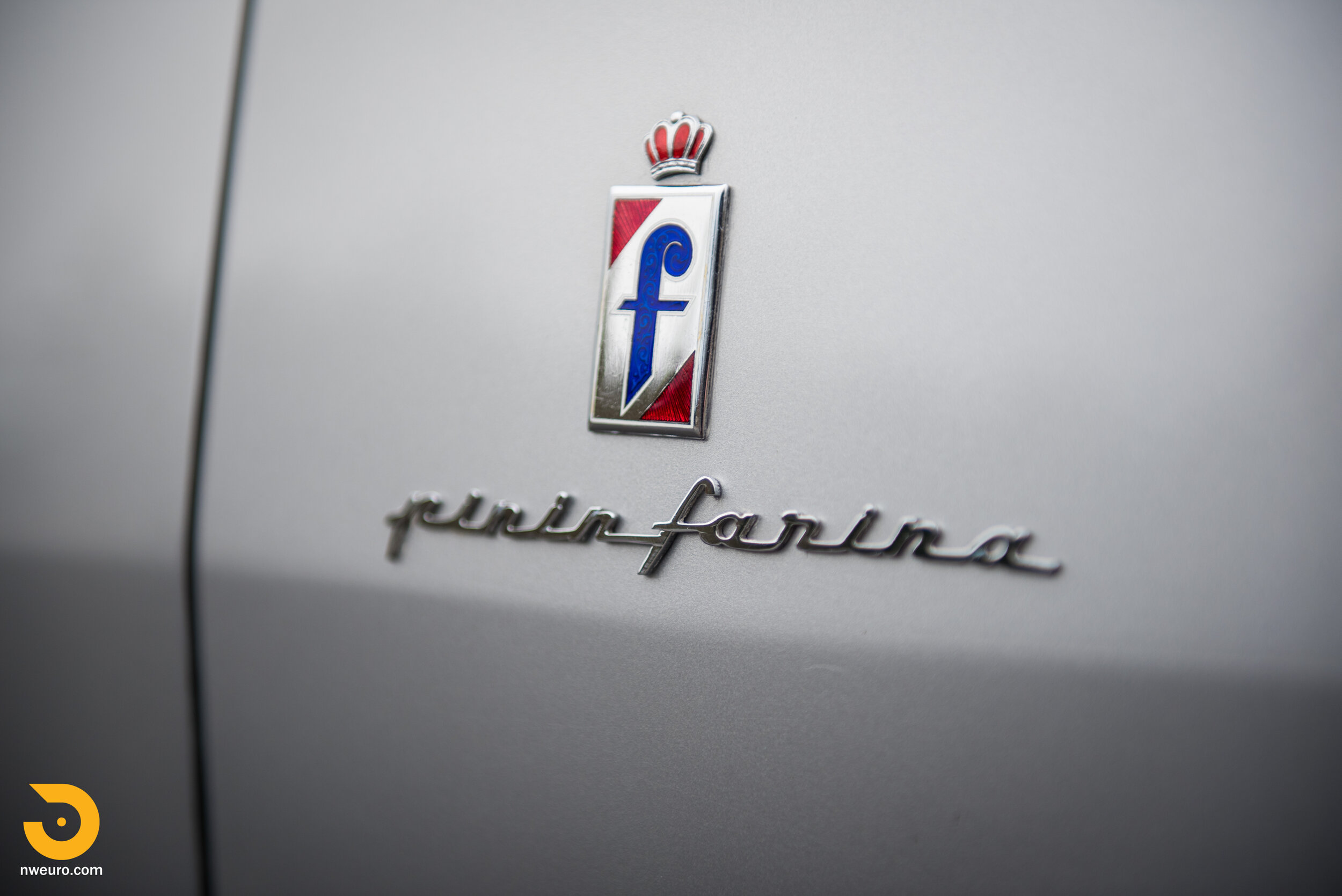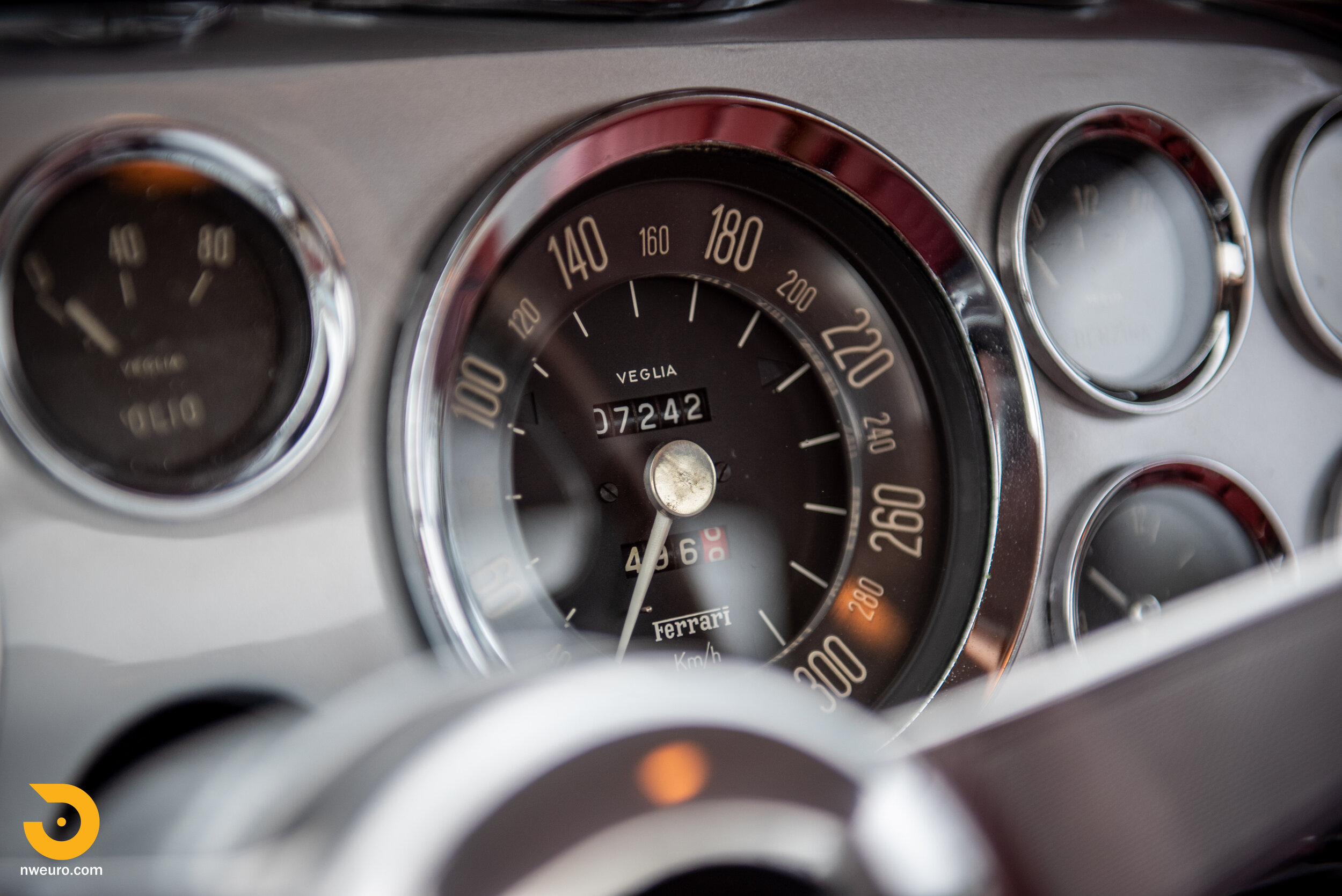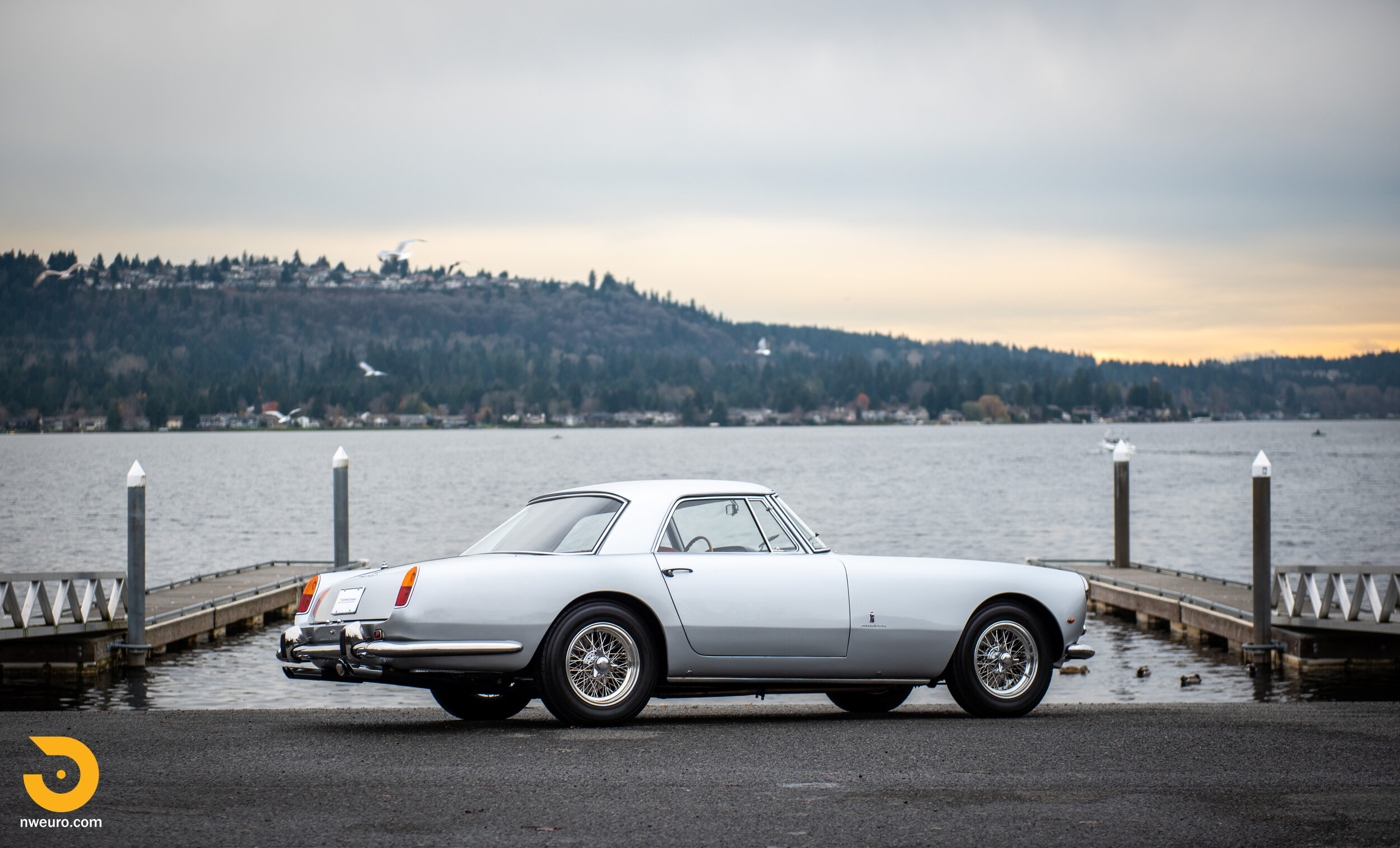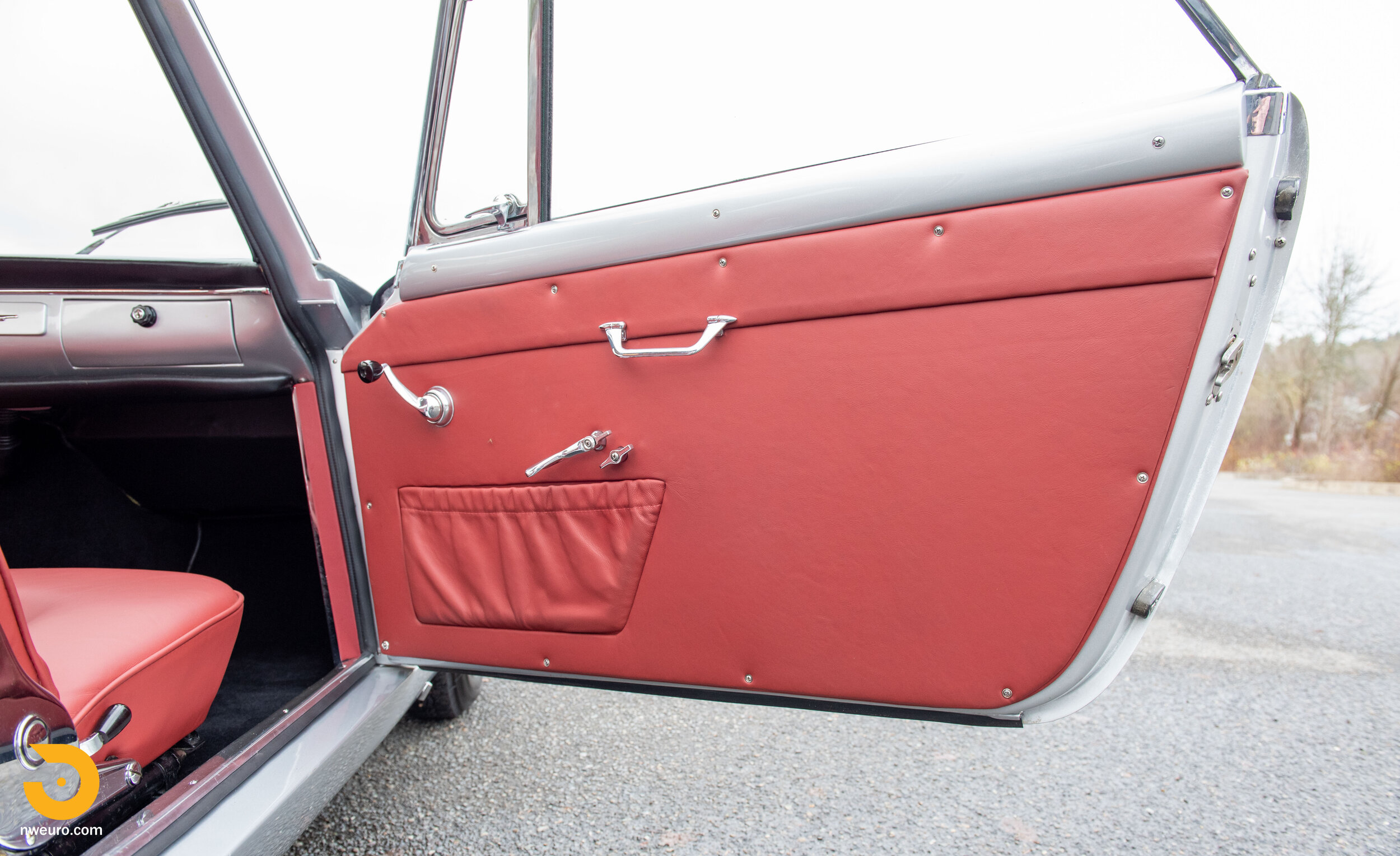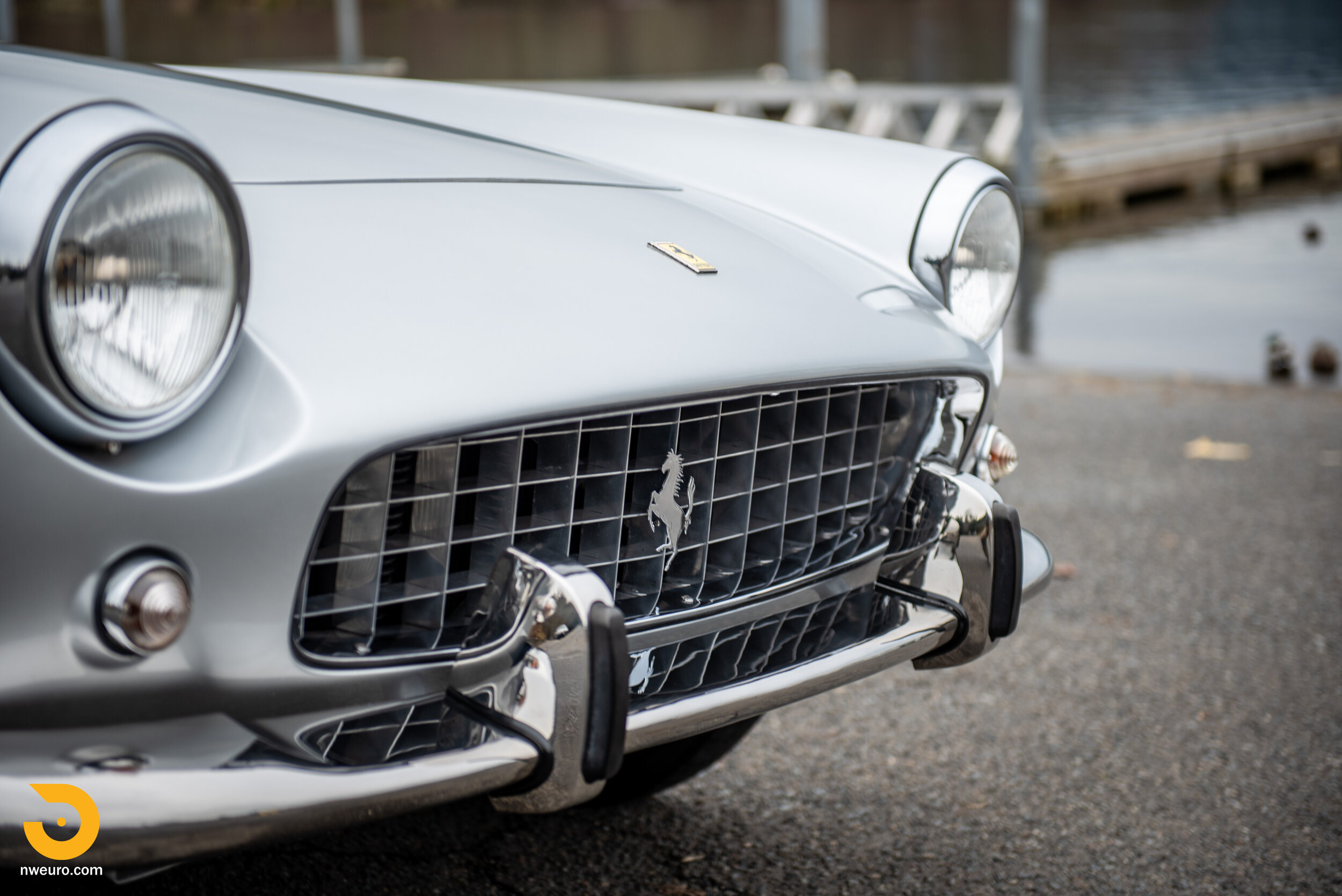1960 Ferrari 250 GT Pinin Farina Coupe
HIGHLIGHTS
Original Matching Numbers Engine & Chassis
45+ year Single Washington State Ownership
One of the last of 353 PF Coupes Built (fewer than 40 made after)
Desirable Series II; Factory Disc Brakes, Overdrive, and Outside-Plug Engine
Presented with Massini Report and Original Italian Documentation
SPECIFICATIONS
Chassis Number - 1851GT
Engine Number - 1851GT
Engine – 2,953 cc Tipo 128F SOHC V-12 with Triple Weber 40 DCL/6 Carburetors producing 240 BHP at 7,000 RPM
Gearbox – 4 Speed Manual with Overdrive
Drivetrain – Front-Engine, RWD
Brakes – 4 Wheel Hydraulic Dunlop Disc Brakes
Suspension - Front Independent Suspension with Coil Springs and Shock Absorbers; Rear Live Axle Suspension with Parallel Trailing Arms, Leaf Springs and Shock Absorbers
PRICING INFORMATION
Price - SOLD
OVERVIEW
Among the more exciting GT cars ever offered by Ferrari, the 250 GT delivered remarkable style and performance at the dawn of a defining decade for race cars and road going sports cars. Ferrari entered the 1960’s eager to meet the growing demand for their capable road cars, in part to fund their racing endeavors, but more immediately to save the desperate financial future of Ferrari. Literally every Ferrari delivered at that time served an invaluable role in keeping Ferrari alive. And while each 250 was uniquely constructed to customer order, the 250 GT took advantage of more refined production methods to meet the welcomed demand both in Europe and the growing North American market. The elegant and clean Pininfarina design offered a spacious trunk, a roomy interior for larger American drivers, and prodigious road manners. Built from 1958-1960, the PF Coupe (as it would eventually become known) would be the most successful volume produced Ferrari of its era, despite only numbering a mere 353 in total production.
Throughout production, the hand-built 250 GT offered exceptional quality, bespoke materials, and distinctive styling, specifically aimed at top Ferrari clientele. Those able to purchase these fine cars were offered Connolly leather, a full complement of performance instruments, and of course an array of stunning colors and interiors from which to choose. And while all Ferraris were expensive propositions, the Pininfarina 250 GT Coupe attracted Hollywood elite, royalty, or wealthy sportsmen, making them all the more exotic to potential new clientele. In late 1959, the Series II PF Coupe evolved to become among the most desirable models due to their improved engine, four speed with overdrive gearbox, and four-wheel disc brakes. Sadly, many 250 GTs have been lost to history, donating their potent light alloy 3.0 liter V12 engines, valuable suspension, and four-wheel disc brakes to replicate racing versions emulating multimillion dollar Ferraris including the now $50 million GTO, 250 SWB, and Tour de France variants, all of which share the same drivetrain as the Coupe. Rarely does a Series II come to market with nearly half a century of single ownership, still retaining the matching numbers engine as delivered from the factory.
This particular 250 GT PF Coupe is one of the last of the desirable Series II versions built. With fewer than 40 cars remaining before production was ceased, chassis 1851 entered Pininfarina March 8,1960 with PF job number 29462. The body was mated to the chassis and the car was finished April 27, 1960 painted Grigio Milano (16201 MM) with blue leather and vinyl interior (Blu VM 3087 Connolly). Factory records indicate the delivery to Mrs. Gabrielle Chiora the first owner on May 18, 1960 in Turin. Mrs. Chiora used the car extensively, with the next notable event being a full factory service at Ferrari in Modena of the car in 1963 showing 28,488km.
Mrs. Chiora sold the car in 1965 to Giacomo Paris, also in Turin, who in turn sold the car in March of 1968 to a Giuseppe Razetto. Mr. Razetto owned the car for only a few months, as the car was then exported to the USA on July 20, 1968. Upon arrival in the USA, Joseph Tourigny, from the Seattle area, would become the next caretaker of 1851 for seven years.
While the first few owners enjoyed touring through the Italian countryside, on the other side of the world a young Pacific Northwest pilot-in-training dreamed of one day owning his own Ferrari. Having worked his way up to co-pilot for Alaska Airlines, he was finally able to fulfill his dream with the purchase of 1851 in 1975 from a local enthusiast (Tourigny) in his hometown. Remarkably, his dream Ferrari would remain under his ownership for the next 46 years.
When the current and consigning owner purchased this car in 1975 it still retained the original Grigio Milano color and all-important matching numbers V12 engine and four-speed gearbox with overdrive. Shortly after his purchase, the owner painted the car dark blue. Handwritten records over the years and receipts for services attest to the level of effort expended to preserve this car and maintain it for enjoyable driving. The owner was highly capable of performing much of his own mechanical work, while a few adventurous fellow pilots brought some much-needed parts in from Italy. He used the car frequently throughout his years living in the Pacific Northwest. During his ownership the car was regularly serviced, often times in his residential garage at a leisurely pace since this was not his daily driver.
In 2005, after decades of enjoyable use and modest mechanical upgrades to improve drivability, the car was taken off the road and work began refreshing the mechanicals and rebuilding the engine for the second time, the first having been done shortly after purchase. Working at a leisurely pace, the project would conclude in 2017 with the engine benefiting from new pistons, new valves, rebuilt carburetors, and a new water pump. The transmission was rebuilt including all synchros, a new clutch, new radiator fan, all new bearings for the differential, a new driveshaft, and an upgraded pinion bearing. Concurrent with the mechanical restoration, in 2012 the owner commissioned a comprehensive respray, tending to the rocker panels, and other areas of the car that had been largely spared from excessive exposure to the elements due to indoor storage. The owner selected the current color silver metallic and in 2017 further commissioned the interior to be reupholstered with red leather.
In addition to the engine, suspension, and transmission work, the electrical system was upgraded as well with new Roelofs Engineering Powermaster 90 amp alternator (using a casting that retains the generator appearance), a new starter motor, a new fuse and relay panel, new electrical wiring for the car, and a brand new set of Marchal headlamps. Additional work on the car further included rebuilding the lever action shock absorbers, rear leaf spring restoration with new plastic dividers inserted in each leaf segment and silent blocks. The brakes were also upgraded with new rotors, new brake lines and a new master cylinder. Upon completion in 2017 the car was sorted and returned to road with a debut showing at the 2018 Ferrari PNW Concours, continuing under the careful stewardship of the same owner who fifty years ago dreamed of buying a Ferrari he could call his own.
Today, this wonderfully presented 250 GT still retains the quality and refinement achieved in the restoration and care delivered over the past years. In addition to the beautiful presentation a November 20, 2020 compression/leak-down test reported 180-200 across all 12 cylinders with 2-5%. The exterior finish is representative of excellent quality cosmetics with glossy silver paint having been professionally detailed and tended to with great care. The panel fit is consistent, with very good door gaps offering a firm snap when closed. The hood, and trunk gaps are excellent, opening and closing smoothly without issue. The chrome plating, lenses, glass, and trim are all properly finished and detailed to a high standard, showing minor evidence of age, a few scuffs and road chip marks, revealing generally very good presentation for paint applied more than 20 years ago. Lettering, emblems, and other elements are finely-detailed finishing touches. The original type 3589 laced Borrani wire wheels are in excellent condition, with polished aluminum rims, stainless steel spokes (replaced some years ago when the wheels were rebuilt) accented by chrome plated knockoffs and correctly sized modern Michelin tires. The distinctive egg crate grille retains a correct, softly dulled finish against the polished grille surround. Correct headlight rings define the distinctive Ferrari fascia of this period with proper Marchal headlamps and hidden fog lights concealed behind the grille. The stance, elegantly dipped belt line, and stately presence delivers a tailored and refined appearance embodying everything that a vintage Ferrari offers for a discerning enthusiast.
The interior is finished with supple red leather, correctly trimmed throughout. The seats offer firm support and proper dimensions along with correct piping and pleating done to a high standard. The owner reports that new foam and rebuilt springs were installed when the interior was redone. An elegant array of restored original gauges presents in excellent condition, very likely only rebuilt as needed as the finishes are nicely warmed from time but appear to have been faithfully preserved. The dash is finished off by a warmly hued wood-rim Nardi steering wheel with polished aluminum spokes and yellow and black prancing horse emblem. Finishes throughout the interior are consistent with an older restoration that has been enjoyed but clearly properly tended to. Most importantly, the interior finishes are in harmony without single elements appearing needy or overdone.
Under the hood, the matching numbers Weber carbureted V12 engine exhibits correct finishes, generally accurate accessories, and original style hardware. This being the later series 1960 128F engine, which did away with its predecessor's Siamese inlets in favor of six separate ports, the spark plugs are positioned on the outside of the cylinder bank. Running three 40 DCL6 Weber carburetors and twin ignition this engine is highly favored over the early series engines. While time has passed since the restoration was freshly completed, ongoing care has been given to each engine component, resulting in modest mechanical patina as one might expect from an authentic sportscar. The unified historic provenance supported by the years of long-term ownership is evident in the casting and stamping numbers, correctly finished features including the textured black cam covers, correct yellow fuel lines, correct carburetors, Fram oil filter housing, and yellow cap battery. The spacious trunk compartment has been nicely finished with correct panels that conceal the matching spare Borrani wire wheel and tire in the recessed trunk location. Further inspection of the undercarriage reveals a well prepared and tidy chassis with the correct type dual exhaust, correct (though possibly not original to this car) aluminum chassis pan, and correct aluminum engine and gearbox castings. The visual inspection of the undercarriage and major chassis tubes reveals no evidence of structural compromise. The front independent suspension, coil springs and shock absorbers are in excellent visual condition. The rear live axle and parallel trailing arms appear to be properly maintained and feature correctly prepared finishes with original details including the faded exhaust decal revealing the Abarth & Co. logo, suppliers of performance exhaust for many 50s and 60s era Ferraris.
The car starts immediately on choke and warms smoothly into a wonderful idle. The gently muffled V12 sounds are a big part of the attraction to these early 250 series cars. Everything about the car is harmonious and comfortable, from the easily engaged shifter, smooth synchros, and sharp throttle to the firm clutch and operable overdrive when properly engaged. On the open road, the overdrive smoothly engages and performs as expected. The drivability and ease of use is a relief from many freshly restored cars that are often only timidly enjoyed when driven. Power is strong when pushed, with progressive throttle response and solid communication from the balanced chassis. Cruising at leisurely speeds, it is easy to see how these cars were so favored by enthusiasts seeking a performance sports car they could drive spiritedly with plenty of trunk space to allow for extended vacations, long road trips, or to hastily purloin fine wines from your family vineyard. This delightful Ferrari Series II 250 GT comes with records from the current long-term owner, hand-written notes and receipts, previous registration records retained during current ownership, numerous vintage photos documenting the restoration and various periods including when the car was first purchased, as well as a tool bag, knock-off hammer, and contemporary scissor jack.
The handsome Ferrari 250 GT has always and will always remain an exceptional sports car combining superlative Italian craftsmanship and sophisticated engineering. As prices for other vaulted 250 series cars continue to rise, collectors have increasingly recognized the substantial value and usability of the PF Coupe. Rare in number and seldom available, the attractive Pininfarina coachwork coupled with 250 Ferrari mechanicals offers dynamic open motoring, rewarding performance, and the thrill of Ferrari ownership. For anyone seeking an enjoyable car ready to use in a wide range of vintage events and proudly display on any show field, this Ferrari awaits you.
Please contact Jason Harris at +1-206-355-7727 for more information on this 1960 Ferrari 250 PF Coupe.





